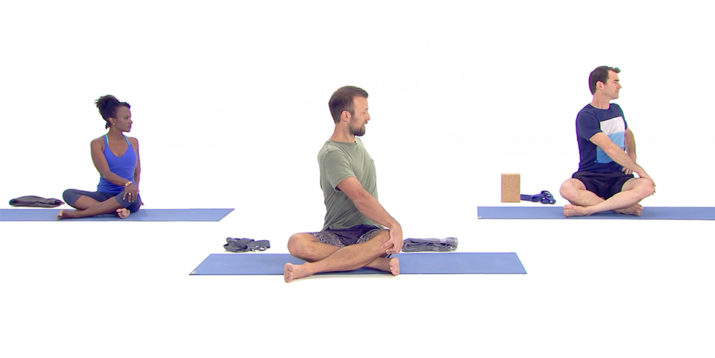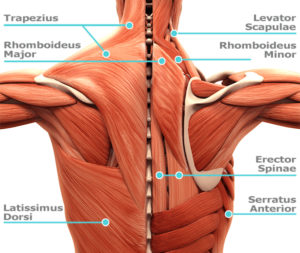7 Back Stretches to Help Ease Pain and Increase Mobility

You don’t realize it, but every day, your back takes a beating.
Whether you spend your day on your feet or on your seat, the muscles from the base of your skull to your tailbone, and from armpit to armpit, get in on the action, keeping you upright, pulling objects toward you, and supporting and moving your shoulder blades as you reach, stretch, and extend your arms. Only when you’re lying flat do all of these muscles get to relax completely.
Is it any wonder your back feels like 20 miles of bad road at the end of a day?
Never fear: The seven back stretches below will not only help you free your flip side, they’ll also help restore proper posture and range of motion. That will make day-to-day activities like sitting and reaching easier and more comfortable.
How to Safely Stretch Your Middle, Lower, and Upper Back
The muscles of the back support and articulate the spine, so you need to exercise some caution when stretching them. Furthermore, the shoulder joint, for all its mobility (more on that later), has a downside, says Beachbody fitness expert Cody Braun: “It’s susceptible to injury.”
So think of stretching not just as lengthening muscles but as learning new ranges in your joints. “Lengthening a muscle takes time,” says Braun. “Some people force mobility by applying extreme tension against the muscle, but this will only lead to pain.”
For especially tight areas, use a foam roller or lacrosse ball to soften the tissue first, then choose a move or two from the list of back stretches below and work on increasing your range of motion — gradually. “This recipe, over time, paired with improved daily posture and movement patterns, will help you move better,” says Braun.
7 Back Stretches for Muscle Pain and Mobility
Ease your way into improved flexibility and range of motion throughout your spine with one or more of these back stretches pulled from Beachbody On Demand.
Seated twist
Benefits: Increases rotational mobility along the spine, stretching muscles throughout the cervical, thoracic, and lumbar regions.
Appears in: 3 Week Yoga Retreat – Week 1, Day 2: Stretch
How to do it:
- Sit cross-legged, left leg in front of your right.
- Sit up tall, lengthening your back and pulling your shoulders back slightly.
- Place your right hand on your left knee, and the fingertips of your left hand on the floor behind you.
- Continuing to lengthen your spine upward, look over your left shoulder, twisting to your left as far as possible.
- Breathe deeply, attempting to rotate farther to the left with each exhale.
- Hold for 20–30 seconds, and repeat on the other side, switching the cross of your legs.
Hand clasp stretch
Benefits: Stretches the lats and trapezius.
Appears in: CORE DE FORCE – MMA Shred
How to do it:
- Stand upright, with your feet shoulder-width apart and your arms extended forward.
- Rotate your palms outward so your thumbs point toward the floor.
- Cross one forearm over the other and bring your palms together.
- Breathing deeply, round your back forward, reaching your arms forward as far as possible.
- Hold the stretch for 20–30 seconds.
3-way back stretch
Benefits: Stretches the lats and the muscles surrounding the rib cage.
Appears in: P90X3 – Total Synergistics
How to do it:
- Stand upright, with your feet shoulder-width apart and your arms extended overhead.
- Interlace your fingers, and flip your hands so your palms face the ceiling. Hold for 5–10 seconds.
- Maintaining the positioning of your arms and hands, bend to your right and hold for 5–10 seconds, repeating the move to your left.
- Returning to an upright position, maintain the position of your arms and hands, and round your back forward until your arms are parallel with the floor, holding for 5–10 seconds.
Bench lat stretch
Benefits: Stretches the lats and helps with overhead shoulder mobility.
Appears in: Body Beast – Build: Back & Bis
How to do it:
- Stand beside an incline bench or other sturdy, chest-high object with your feet wider than hip distance, and place your right elbow on top of the back support.
- Placing your right hand behind your head, slowly lower your body toward the floor, until you feel a deep stretch along your right side.
- Hold for 20–30 seconds, then repeat on the other side.
Stability ball lat stretch
Benefits: Stretches the lats and muscles in the shoulder through contraction and relaxation, while improving mobility in the overhead position.
Appears in: P90X2 – P.A.P. Upper
How to do it:
- From a kneeling position, place the backs of your hands on top of a stability ball (or chair), with your arms extended and your head in a neutral position.
- Keeping your back flat and your arms straight, lower your chest toward the floor, and sink into the stretch, while pressing the backs of your hands into the ball. Hold for 5 seconds.
- Remaining in the stretched position, release the downward tension on the ball for 5 seconds, and try to sink deeper into the stretch.
Revolved chair
Benefits: Promotes rotational mobility along the spine, stretching the middle- and lower-back muscles.
Appears in: Beachbody Yoga Studio – Get Centered with Elise
How to do it:
- Stand with your feet together, palms pressed together in front of your chest, elbows out.
- Keeping your back flat and your knees together, push your hips back, bend your knees, and lower your body until your hips are around knee level.
- With your back still flat and your elbows wide, twist your upper body to the left, placing the back of your right elbow against the outside of your left knee.
- Hold for a five-count, then repeat on the other side.
Supine twist
Benefits: Improves rotational mobility of the spine, and stretches muscles all along the upper and lower back, as well as the hips.
Appears in: 21 Day Fix – Yoga Fix
- Lie on your back, with your arms extended out to your sides and your palms down, bringing your knees toward your chest.
- Keeping both shoulders on the floor, slowly turn your head to the right and lower your knees toward the floor to your left (if you feel a deep stretch in this position, stop here).
- For a deeper stretch, extend your left leg downward, place your left hand on the outside of your right knee and breathe deeply, pressing your right knee toward the floor.
- Hold whichever version of the stretch is appropriate for 20–30 seconds, then repeat on the other side.
Why Back Muscles Get Tight
“Your shoulder is one of the most mobile joints in the body,” says Braun. As kids, we took advantage of that range of motion, climbing trees, traversing monkey bars, and throwing objects of all kinds, which helped our shoulders — and the back muscles that support and control them — stay mobile and healthy.
But the average adult’s habitual range of motion is much less varied. Most of us spend our days at a desk, says Braun, which keeps the lats in a perpetually shortened position. We rarely twist, or reach behind us.
Desk sitting has consequences for other back muscles as well. The upper fibers of the trapezius — which extends from the sides of your neck to your shoulders — become overactive, causing the shoulders to shrug slightly, and making the muscles feel tender to the touch.
Simultaneously, slouching causes the upper back to round forward, creating a hunched appearance — a position you may be holding right now. As your head angles downward, the muscles in the middle of your back have to work harder than usual to support it — which explains the chronic upper-back, neck, and shoulder tightness experienced by many desk sitters. The result leaves your neck sore and your chest muscles tight from constant contraction, further perpetuating the problem.
Primary Muscles of the Back
At first glance, the back looks like a morass of musculature, with fibers and Latin names running every which way. For stretching purposes, think of the back muscles as four major groups: the trapezius, the rhomboids, the latissimus dorsi, and the erector spinae.
 Trapezius
Trapezius
Starting at the top of your neck, your traps are formed by the kite-shaped muscles that extend from the base of your skull to just above your lower back, with points extending to your shoulder blades on either side. Their job: to move the shoulder blades upward, downward, and together, and to aid in turning and tilting the head.
Rhomboids
Working downward, the scapular stabilizers are a series of small muscles connecting the shoulder blades to numerous points along the torso. Their primary job is to prevent undue movement in the shoulder blades while you throw, pull, and push. They include:
Rhomboids major and minor, which run from the inner edge of your scapula to your spine
Levator scapulae on the sides of your neck, which help the upper traps lift the shoulders
Serratus anterior, which pulls the shoulder blades forward, as when a boxer goes for a knockout punch (which is why it’s often referred to as the boxer’s muscle).
Latissimus dorsi
The largest muscles of the back are the lats, the flat, winglike slabs at either side of your back that run from your hips and sacrum to your underarms, and attach at your upper arms. They’re responsible for pulling your arms down and behind you, and rotating your upper arms inward.
Erector spinae
This is the group of garden hose-like muscles that flank your spine from your neck all the way down to your sacrum. They keep you upright, extending and stabilizing your spine when you bend to your sides, look upward, turn your head, or peel off the floor from your belly. There are three major erector muscles, each a different length: (from the spine outward) the spinalis, the longissimus, and the iliocostalis.
